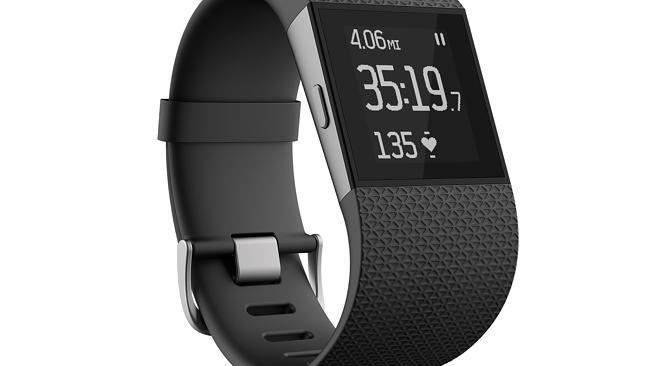Fitbit Surge, a rugged watch for fitness buffs
FITBIT’S Surge combines extended activity monitoring with basic smartwach functions.

IN bygone days when desktop computers were the rage, reviewing tech gear could be a relaxing, sedentary affair. Alas, with activity devices the rage, we tech journos now have to pound pavements, while checking steps, heart rates, music connectivity and notifications. So much exercise.
Such was the case last week when, late at night, I was power walking my way in drizzle around Newtown in inner Sydney testing Fitbit’s latest wearable, the Surge Fitness Super Watch. It’s one of three new Fitbit devices: the Charge and Charge HR wristbands being the others.
There’s a particular reason to test the Surge. It combines all of Fitbit’s traditional fitness monitoring with some rudimentary smartwatch functionality. It’s an early example of the merger of these two device genres that will become common. Smartwatches already count steps, so why shouldn’t Fitbits show phone notifications?
The Surge is more a rugged fitness watch than elegant smartwatch. It has a 21x24mm-square display and a thick non-detachable watchband with normal watch clasp. The display is, sadly, a monochrome e-ink low-resolution one. It is, however, backlit and touch-sensitive.
Turn it over and there’s a heart rate monitor and the same proprietary charging port found on the Charge and Charge HR. It’s splash proof, not waterproof — the manual says not to shower or swim with the Surge. Given swimming is a common fitness activity, that’s a shame. We should expect our top-of-range activity monitors to be waterproof.
You get a choice of four digital and analog clock faces with the Surge. In a layout reminiscent of the Pebble watch, the Surge has three buttons. You press buttons or swipe to operate it.
Swiping leftward from the clock face brings up the same stats found on other Fitbit devices: steps, live heart rate, kilometres, calories burned and floors climbed. The extra functionality kicks in when you press “home” and access extended activity monitoring.
You can set up the Surge to monitor running, walking, stair climbing, a workout, a weights session, hiking, yoga, pilates, kickboxing, golf, tennis and more. You use the Fitbit app to configure which of these activities show on the watch menu. So far cycling isn’t among them. Some activities access the Surge’s star feature, in-built GPS. When I chose to walk, the Surge first activated GPS. I could then press a stopwatch button to begin. It records steps, heart rate, and calories burned — independently from default daily aggregates.
In the end, what I got was a well-designed graphical presentation of the activity, showing not just overall performance, but a map, time splits for each kilometre travelled, and minutes spent in each heart rate zone. The categories were out of zone (sedentary), fat burning, cardio and peak.
Finally, there was a point to recording heart rates: at a glance I could see how strenuously or otherwise I exercised on that route and whether to up the pace next time. In the past I had used the Runkeeper app to log walks graphically, but I haven’t seen an application with such useful integration of heart rate data.
To save battery life, the GPS isn’t active when you select an activity that doesn’t use it, or just depend on the default activity monitoring screen. Fitbit does recommend you recharge Surge after using GPS. Without GPS Fitbit says the battery will last seven days, but I could not verify this in the shorter time I had the device.
As for smartwatch integration, it is basic. The Surge connects to smartphones using Bluetooth 4.0 and this worked with both an Android phone and an iPhone. When walking, I could pause and start music and skip tracks from the watchface. But occasionally the connection dropped out. And you only get SMS notifications, not email ones.
You can set vibrating alarms on the Surge and I can testify you won’t miss them. You get a real zap. Surge also monitors sleep without you prompting it to begin.
Costing $150 more than the Charge HR, the Surge is definitely worth the money if you want the extended activity monitoring it offers, or prefer a larger watch-sized device than an activity band.
Price $349.95
Rating: 7.5/10


